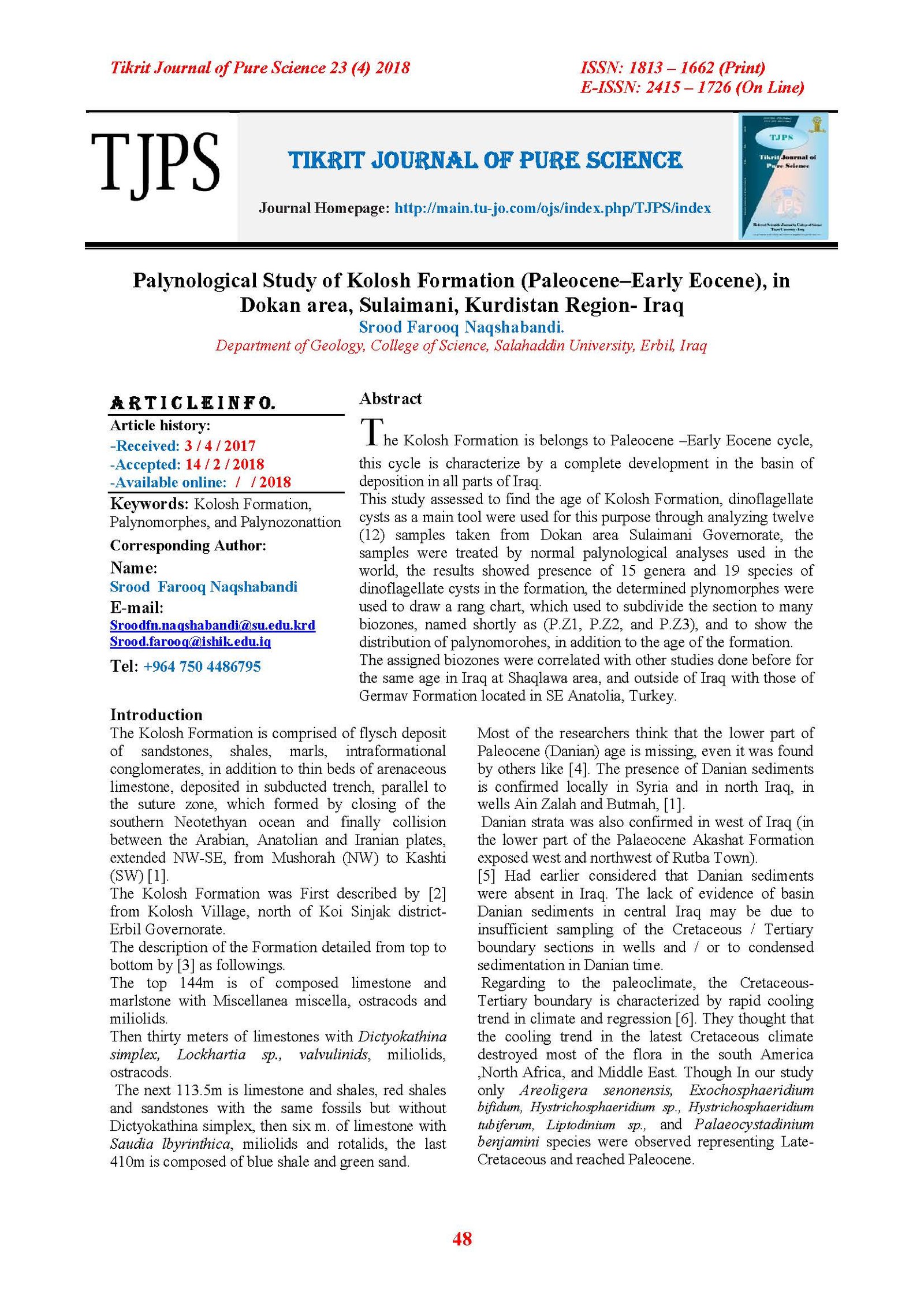Palynological Study of Kolosh Formation (Paleocene–Early Eocene), in Dokan area, Sulaimani, Kurdistan Region- Iraq
Main Article Content
Abstract
The Kolosh Formation is belongs to Paleocene –Early Eocene cycle, this cycle is characterize by a complete development in the basin of deposition in all parts of Iraq.
This study assessed to find the age of Kolosh Formation, dinoflagellate cysts as a main tool were used for this purpose through analyzing twelve (12) samples taken from Dokan area Sulaimani Governorate, the samples were treated by normal palynological analyses used in the world, the results showed presence of 15 genera and 19 species of dinoflagellate cysts in the formation, the determined plynomorphes were used to draw a rang chart, which used to subdivide the section to many biozones, named shortly as (P.Z1, P.Z2, and P.Z3), and to show the distribution of palynomorohes, in addition to the age of the formation.
The assigned biozones were correlated with other studies done before for the same age in Iraq at Shaqlawa area, and outside of Iraq with those of Germav Formation located in SE Anatolia, Turkey.
Article Details

This work is licensed under a Creative Commons Attribution 4.0 International License.
Tikrit Journal of Pure Science is licensed under the Creative Commons Attribution 4.0 International License, which allows users to copy, create extracts, abstracts, and new works from the article, alter and revise the article, and make commercial use of the article (including reuse and/or resale of the article by commercial entities), provided the user gives appropriate credit (with a link to the formal publication through the relevant DOI), provides a link to the license, indicates if changes were made, and the licensor is not represented as endorsing the use made of the work. The authors hold the copyright for their published work on the Tikrit J. Pure Sci. website, while Tikrit J. Pure Sci. is responsible for appreciate citation of their work, which is released under CC-BY-4.0, enabling the unrestricted use, distribution, and reproduction of an article in any medium, provided that the original work is properly cited.
References
[1]-Jassim S.Z, Goff, J. (eds) Geology of Iraq, Dolin, Prague, and Moravian Museum. Czech Republic, Brno, pp 71–83
[2]-Dunnington, H.V., 1953a’ Surface rock unit nomenclature for North Iraq Manuscript report, No. IDLR, INOC library, Baghdad
[3]-Bellen, R. C., Van, Dunnington, H. V., Wetzel, R. and Morton, D. M., 1959, Lexique Stratigraphique International. V. III, Asie, Fasc., 10a Iraq. Paris. 333P.
[4]-Jassim, S.Z., Karim, S.A., Basi, M., Al-Mubarak, M.A., and Munir, J., 1984” Final report on the general geological survey of Iraq, Vol.3 Stratigraphical manuscript report, geological survey of Iraq.
[5]-Kassab, I.I.M. 1975b: “Biostratigraphic study on the subsurface Upper Cretaceous-Lower Tertiary, of the well Injana, No.5 North Eastern Iraq, J. Geo. Society, Iraq, special Issue, Baghdad
[6]-Ertug, K., Bozdogan, N., Ediger, V.S., 1990: Dinoflagellate Cysts from the Maastrichtian – Paleocene Boundary, Turkish Petroleum Corporation, S.E. Anatolia, Reserch Center, Ankara,06420 Turkey, Revizta Española de Micropaleontologia vol.xxii, n.2.
[7]-Soliman, A. Thomas, J. S., Alexander. L & Herbert S, 2009: Dinoflagellate Cysts & Ammonoids from Upper Cretaceous sediments of the Pemberger Formation (Krapfeld, Carinthia, Austria), Ann. Naturhist Musiwien–110A-401-421-Wien, Jänner, 3pls., 2fig.,1 table.
[8]-Ditmar, V. and Iraqi soviet team, 1971, Geological conditions and hydrocarbon prospects of the Republic of Iraq (Northern and Central parts). Techno Export. INOC library, Baghdad.
[9]-Seilacher, A., 1963. Kaledonischer Unterbau der Irakiden. Neues Jahrb. Geol. Paleont. Abt. A. Monatshefte No. 10.
[10]-Jassim, S. Z., Al Shaibani, S.K. and Ajina, T. M., 1975. Possible Middle Eocene block movements in the Derbendikhan area, Northeastern Iraq J. Geol. Soc. Iraq, Special Issue, Baghdad.
[11]-Hanna, M. T. 1993: Palynology of the Cretaceous-Tertiary boundary in Hijran Area, Northeastern Iraq. M.Sc. Thesis, University of Salahaddin ,Iraq.
[12]-Karim, K.H. 2016; lateral and vertical facies changes of kolosh Formation in Sulaimani and Duhok areas, Journal of Geography and Geology, vol.8, No.1
[13]19-Sissakian, V. K., 2000: Geological map of Iraq, sheet, No.1, scale 1: 1000 000, State establishment of Geological Survey and Mining, Geoserv, Baghdad, Iraq.
[14]2-Buday, T., 1980. The Regional Geology of Iraq, Part1: Stratigraphy and Paleogeography. Geol. Surv. Min. Invest., Baghdad, 445P.
[15]21-Varma, C.P. & Dangwal, A.K., 1964: Tertiary hystrichosphaerids from India.- Micrpaleontology, 10,No.1, 63-71, New York .-S.64, Taf.1, fig.8-9, in Eisenack 1971, Dinoflagellaten, Band II.
[16]22-Wall, D., 1967: Fossil microplankton in deep- sea cores from the Caribbean Sea- Palaeontology, 10, 95-123, London, -S. 103, taf.13, Fig.16, Abb.2 , in Eisenack Band II, 1971 .
[17]-William R. E, 1975: Proceedings of Forum on Dinoflagellates held at Anaheim California, Stanford University, as part of the sixth Annual Meeting, A.A.S.P Contribution series, n.4.
[18]-Wilson, L. & Williams, 1979: A population study of Alterbia acutula from the Maastrichtian (Up. Cret.) of Maryland, Palynology, vol3.
[19]- Cheng - Long Shaw, 2004: Eocene Areoligeraceous Dinoflagellate Cysts of Taiwan, Taiwania,49(2), 118-123.
